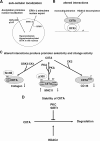Regulating the activity of class II transactivator by posttranslational modifications: exploring the possibilities
- PMID: 19720744
- PMCID: PMC2772741
- DOI: 10.1128/MCB.00661-09
Regulating the activity of class II transactivator by posttranslational modifications: exploring the possibilities
Abstract
First identified as the master regulator of major histocompatibility complex II transcription, class II transactivator (CIITA) has since been implicated in a host of pathologies by modulating the transcription of multiple different genes. How CIITA caters to cell- and tissue-specific transcriptional needs is hotly debated and investigated. One of the possible mechanisms underlying spatiotemporal control of CIITA transcriptional activity is the posttranslational modification (PTM) machinery that refines certain amino acid residues of CIITA and hence alters its activity in response to specific cellular and environmental cues. This review discusses our current understanding of the PTM map of CIITA, how these modifications fine-tune its activity, and how the study of this area may lead to potential therapeutic strategies.
Figures


Similar articles
-
Phosphorylation and ubiquitination of degron proximal residues are essential for class II transactivator (CIITA) transactivation and major histocompatibility class II expression.J Biol Chem. 2010 Aug 20;285(34):25893-903. doi: 10.1074/jbc.M110.127746. Epub 2010 Jun 10. J Biol Chem. 2010. PMID: 20538595 Free PMC article.
-
Degradation, Promoter Recruitment and Transactivation Mediated by the Extreme N-Terminus of MHC Class II Transactivator CIITA Isoform III.PLoS One. 2016 Feb 12;11(2):e0148753. doi: 10.1371/journal.pone.0148753. eCollection 2016. PLoS One. 2016. PMID: 26871568 Free PMC article.
-
The class II transactivator (CIITA) is regulated by post-translational modification cross-talk between ERK1/2 phosphorylation, mono-ubiquitination and Lys63 ubiquitination.Biosci Rep. 2015 Jun 19;35(4):e00233. doi: 10.1042/BSR20150091. Biosci Rep. 2015. PMID: 26181363 Free PMC article.
-
Expression of MHC II genes.Curr Top Microbiol Immunol. 2005;290:147-70. doi: 10.1007/3-540-26363-2_7. Curr Top Microbiol Immunol. 2005. PMID: 16480042 Review.
-
Mini-review: Specificity and expression of CIITA, the master regulator of MHC class II genes.Eur J Immunol. 2004 Jun;34(6):1513-25. doi: 10.1002/eji.200424964. Eur J Immunol. 2004. PMID: 15162420 Review.
Cited by
-
New Insight in HDACs: Potential Therapeutic Targets for the Treatment of Atherosclerosis.Front Pharmacol. 2022 Apr 21;13:863677. doi: 10.3389/fphar.2022.863677. eCollection 2022. Front Pharmacol. 2022. PMID: 35529430 Free PMC article. Review.
-
SIRT1 links CIITA deacetylation to MHC II activation.Nucleic Acids Res. 2011 Dec;39(22):9549-58. doi: 10.1093/nar/gkr651. Epub 2011 Sep 2. Nucleic Acids Res. 2011. PMID: 21890893 Free PMC article.
-
CIITA and Its Dual Roles in MHC Gene Transcription.Front Immunol. 2013 Dec 20;4:476. doi: 10.3389/fimmu.2013.00476. Front Immunol. 2013. PMID: 24391648 Free PMC article.
-
Extracellular matrix synthesis in vascular disease: hypertension, and atherosclerosis.J Biomed Res. 2014 Jan;28(1):25-39. doi: 10.7555/JBR.27.20130064. Epub 2013 Sep 20. J Biomed Res. 2014. PMID: 24474961 Free PMC article. Review.
-
PML promotes MHC class II gene expression by stabilizing the class II transactivator.J Cell Biol. 2012 Oct 1;199(1):49-63. doi: 10.1083/jcb.201112015. Epub 2012 Sep 24. J Cell Biol. 2012. PMID: 23007646 Free PMC article.
References
-
- Abbas, T., D. White, L. Hui, K. Yoshida, D. A. Foster, and J. Bargonetti. 2004. Inhibition of human p53 basal transcription by down-regulation of protein kinase Cdelta. J. Biol. Chem. 279:9970-9977. - PubMed
-
- Asher, G., D. Gatfield, M. Stratmann, H. Reinke, C. Dibner, F. Kreppel, R. Mostoslavsky, F. W. Alt, and U. Schibler. 2008. SIRT1 regulates circadian clock gene expression through PER2 deacetylation. Cell 134:317-328. - PubMed
-
- Cressman, D. E., K. C. Chin, D. J. Taxman, and J. P. Ting. 1999. A defect in the nuclear translocation of CIITA causes a form of type II bare lymphocyte syndrome. Immunity 10:163-171. - PubMed
-
- Fikrig, E., S. W. Barthold, M. Chen, C. H. Chang, and R. A. Flavell. 1997. Protective antibodies develop, and murine Lyme arthritis regresses, in the absence of MHC class II and CD4+ T cells. J. Immunol. 159:5682-5686. - PubMed
Publication types
MeSH terms
Substances
Grants and funding
LinkOut - more resources
Full Text Sources
